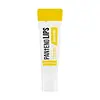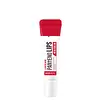What's inside
What's inside
 Key Ingredients
Key Ingredients

 Benefits
Benefits

 Concerns
Concerns

 Ingredients Side-by-side
Ingredients Side-by-side

Paraffinum Liquidum
EmollientPolyisobutene
Ethylene/Propylene/Styrene Copolymer
Helianthus Annuus Seed Oil
EmollientParfum
MaskingGlycerin
HumectantButylene/Ethylene/Styrene Copolymer
Cetearyl Olivate
Macadamia Ternifolia Seed Oil
EmollientOlea Europaea Fruit Oil
MaskingPersea Gratissima Oil
Skin ConditioningEclipta Prostrata Extract
Skin ConditioningSorbitan Olivate
EmulsifyingWater
Skin ConditioningGlycine Soja Oil
EmollientTocopherol
AntioxidantTocopheryl Acetate
AntioxidantMelia Azadirachta Leaf Extract
Skin ConditioningPropolis Extract
Skin ConditioningPanthenol
Skin ConditioningBenzyl Salicylate
PerfumingLinalool
PerfumingBHT
AntioxidantHexyl Cinnamal
PerfumingHydroxycitronellal
PerfumingCitronellol
PerfumingCinnamyl Alcohol
PerfumingMoringa Oleifera Seed Oil
EmollientBixa Orellana Seed Oil
EmollientRoyal Jelly Extract
Skin ConditioningHoney Extract
HumectantCollagen
Moisturising1,2-Hexanediol
Skin ConditioningLeuconostoc/Radish Root Ferment Filtrate
AntimicrobialParaffinum Liquidum, Polyisobutene, Ethylene/Propylene/Styrene Copolymer, Helianthus Annuus Seed Oil, Parfum, Glycerin, Butylene/Ethylene/Styrene Copolymer, Cetearyl Olivate, Macadamia Ternifolia Seed Oil, Olea Europaea Fruit Oil, Persea Gratissima Oil, Eclipta Prostrata Extract, Sorbitan Olivate, Water, Glycine Soja Oil, Tocopherol, Tocopheryl Acetate, Melia Azadirachta Leaf Extract, Propolis Extract, Panthenol, Benzyl Salicylate, Linalool, BHT, Hexyl Cinnamal, Hydroxycitronellal, Citronellol, Cinnamyl Alcohol, Moringa Oleifera Seed Oil, Bixa Orellana Seed Oil, Royal Jelly Extract, Honey Extract, Collagen, 1,2-Hexanediol, Leuconostoc/Radish Root Ferment Filtrate
Water
Skin ConditioningPanthenol
Skin ConditioningSorbitol
HumectantIsohexadecane
EmollientCaprylic/Capric Triglyceride
MaskingGlycerin
HumectantDilinoleic Acid/Propanediol Copolymer
EmollientCetearyl Alcohol
EmollientDiisostearyl Malate
EmollientMacadamia Ternifolia Seed Oil
EmollientPEG/PPG-17/6 Copolymer
SolventPhytosteryl Sunflowerseedate
Skin ConditioningBeeswax
Emulsion StabilisingPolysorbate 60
EmulsifyingGlyceryl Stearate
EmollientMethyl Glucose Sesquistearate
EmollientSorbitan Sesquioleate
EmulsifyingHydrogenated Vegetable Glycerides
EmollientDimethicone
Emollient1,2-Hexanediol
Skin ConditioningTocopheryl Acetate
AntioxidantPEG-100 Stearate
Arginine
MaskingCarbomer
Emulsion StabilisingButylene Glycol
HumectantCaprylhydroxamic Acid
Sodium Acrylate/Sodium Acryloyldimethyl Taurate Copolymer
Emulsion StabilisingAllantoin
Skin ConditioningParfum
MaskingPolysorbate 80
EmulsifyingDisodium EDTA
Sodium Hyaluronate
HumectantHelianthus Annuus Seed Oil
EmollientOlea Europaea Fruit Oil
MaskingArgania Spinosa Kernel Oil
EmollientSorbitan Oleate
EmulsifyingWater, Panthenol, Sorbitol, Isohexadecane, Caprylic/Capric Triglyceride, Glycerin, Dilinoleic Acid/Propanediol Copolymer, Cetearyl Alcohol, Diisostearyl Malate, Macadamia Ternifolia Seed Oil, PEG/PPG-17/6 Copolymer, Phytosteryl Sunflowerseedate, Beeswax, Polysorbate 60, Glyceryl Stearate, Methyl Glucose Sesquistearate, Sorbitan Sesquioleate, Hydrogenated Vegetable Glycerides, Dimethicone, 1,2-Hexanediol, Tocopheryl Acetate, PEG-100 Stearate, Arginine, Carbomer, Butylene Glycol, Caprylhydroxamic Acid, Sodium Acrylate/Sodium Acryloyldimethyl Taurate Copolymer, Allantoin, Parfum, Polysorbate 80, Disodium EDTA, Sodium Hyaluronate, Helianthus Annuus Seed Oil, Olea Europaea Fruit Oil, Argania Spinosa Kernel Oil, Sorbitan Oleate
 Reviews
Reviews

Ingredients Explained
These ingredients are found in both products.
Ingredients higher up in an ingredient list are typically present in a larger amount.
1,2-Hexanediol is a synthetic liquid and another multi-functional powerhouse.
It is a:
- Humectant, drawing moisture into the skin
- Emollient, helping to soften skin
- Solvent, dispersing and stabilizing formulas
- Preservative booster, enhancing the antimicrobial activity of other preservatives
Glycerin is already naturally found in your skin. It helps moisturize and protect your skin.
A study from 2016 found glycerin to be more effective as a humectant than AHAs and hyaluronic acid.
As a humectant, it helps the skin stay hydrated by pulling moisture to your skin. The low molecular weight of glycerin allows it to pull moisture into the deeper layers of your skin.
Hydrated skin improves your skin barrier; Your skin barrier helps protect against irritants and bacteria.
Glycerin has also been found to have antimicrobial and antiviral properties. Due to these properties, glycerin is often used in wound and burn treatments.
In cosmetics, glycerin is usually derived from plants such as soybean or palm. However, it can also be sourced from animals, such as tallow or animal fat.
This ingredient is organic, colorless, odorless, and non-toxic.
Glycerin is the name for this ingredient in American English. British English uses Glycerol/Glycerine.
Learn more about GlycerinHelianthus Annuus Seed Oil is the oil derived from the seeds of a Sunflower. Sunflower seed oil is non-fragrant. It is an emollient, meaning it helps to soften the skin.
Sunflower seed oil contains many fatty acids. The fatty acids found in sunflower seeds include (from highest amount to least): linoleic acid, myristic acid, palmitic acid, stearic acid, arachidic acid, oleic acid, and linolenic acid.
These fatty acids help the skin create ceramides. Ceramides play a role in repairing the skin barrier.
Helianthus Annuus Seed Oil helps moisturize the skin. This in turn helps the skin look more rejuvenated and smoother.
Sunflowers are rich in vitamin E.
Historians believe Indigenous cultures of North America domesticated sunflowers before corn. Thus they relied on sunflower oil for a variety of uses. One such use is moisturizing skin and hair.
Sunflower seed oil may not be fungal acne safe. We recommend speaking with a professional if you have any concerns.
Learn more about Helianthus Annuus Seed OilMacadamia Ternifolia Seed Oil is the fixed oil obtained from Macadamia nut.
Macadamia seed oil is rich in fatty acids, including oleic acid (45-75%), palmitoleic acid (7-33%), and palmitic acid (6-12%). They also contain various B vitamins, iron, and magnesium.
Palmitoleic acid has been shown to help soothe inflammation and promote wound healing. It is also naturally found in the fat of our skin.
Macadamia seed oil may not be malassezia folliculitis, or fungal-acne, safe.
Learn more about Macadamia Ternifolia Seed OilOlea Europaea Fruit Oil is the fixed oil obtained from the ripe fruit of the Olive. In other words - olive oil.
The primary contents of olive oil are glycerides of the fatty acids linoleic, oleic and palmitic.
Olive oil also contains antioxidants such as Vitamin E. Antioxidants may help reduce signs of aging by fighting unstable free-radical molecules. It also contains Vitamins A (retinol), D, and K.
The squalene in olive oil makes it a great emollient. Emollients help soothe and soften your skin by trapping moisture in. This makes olive oil a great skin moisturizer.
Studies show olive oil to have antibacterial and antifungal properties in low concentrations. Another study found olive oil irritated sensitive oily skin. We always recommend speaking with a professional about using this ingredient in your routine.
Due to the fatty acid content, this ingredient may not be fungal-acne safe.
Learn more about Olea Europaea Fruit OilPanthenol is a common ingredient that helps hydrate and soothe the skin. It is found naturally in our skin and hair.
There are two forms of panthenol: D and L.
D-panthenol is also known as dexpanthenol. Most cosmetics use dexpanthenol or a mixture of D and L-panthenol.
Panthenol is famous due to its ability to go deeper into the skin's layers. Using this ingredient has numerous pros (and no cons):
Like hyaluronic acid, panthenol is a humectant. Humectants are able to bind and hold large amounts of water to keep skin hydrated.
This ingredient works well for wound healing. It works by increasing tissue in the wound and helps close open wounds.
Once oxidized, panthenol converts to pantothenic acid. Panthothenic acid is found in all living cells.
This ingredient is also referred to as pro-vitamin B5.
Learn more about PanthenolParfum is a catch-all term for an ingredient or more that is used to give a scent to products.
Also called "fragrance", this ingredient can be a blend of hundreds of chemicals or plant oils. This means every product with "fragrance" or "parfum" in the ingredients list is a different mixture.
For instance, Habanolide is a proprietary trade name for a specific aroma chemical. When used as a fragrance ingredient in cosmetics, most aroma chemicals fall under the broad labeling category of “FRAGRANCE” or “PARFUM” according to EU and US regulations.
The term 'parfum' or 'fragrance' is not regulated in many countries. In many cases, it is up to the brand to define this term.
For instance, many brands choose to label themselves as "fragrance-free" because they are not using synthetic fragrances. However, their products may still contain ingredients such as essential oils that are considered a fragrance by INCI standards.
One example is Calendula flower extract. Calendula is an essential oil that still imparts a scent or 'fragrance'.
Depending on the blend, the ingredients in the mixture can cause allergies and sensitivities on the skin. Some ingredients that are known EU allergens include linalool and citronellol.
Parfum can also be used to mask or cover an unpleasant scent.
The bottom line is: not all fragrances/parfum/ingredients are created equally. If you are worried about fragrances, we recommend taking a closer look at an ingredient. And of course, we always recommend speaking with a professional.
Learn more about ParfumTocopheryl Acetate is AKA Vitamin E. It is an antioxidant and protects your skin from free radicals. Free radicals damage the skin by breaking down collagen.
One study found using Tocopheryl Acetate with Vitamin C decreased the number of sunburned cells.
Tocopheryl Acetate is commonly found in both skincare and dietary supplements.
Learn more about Tocopheryl AcetateWater. It's the most common cosmetic ingredient of all. You'll usually see it at the top of ingredient lists, meaning that it makes up the largest part of the product.
So why is it so popular? Water most often acts as a solvent - this means that it helps dissolve other ingredients into the formulation.
You'll also recognize water as that liquid we all need to stay alive. If you see this, drink a glass of water. Stay hydrated!
Learn more about Water